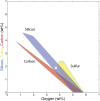A seismologically consistent compositional model of Earth's core
- PMID: 24821817
- PMCID: PMC4040578
- DOI: 10.1073/pnas.1316708111
A seismologically consistent compositional model of Earth's core
Abstract
Earth's core is less dense than iron, and therefore it must contain "light elements," such as S, Si, O, or C. We use ab initio molecular dynamics to calculate the density and bulk sound velocity in liquid metal alloys at the pressure and temperature conditions of Earth's outer core. We compare the velocity and density for any composition in the (Fe-Ni, C, O, Si, S) system to radial seismological models and find a range of compositional models that fit the seismological data. We find no oxygen-free composition that fits the seismological data, and therefore our results indicate that oxygen is always required in the outer core. An oxygen-rich core is a strong indication of high-pressure and high-temperature conditions of core differentiation in a deep magma ocean with an FeO concentration (oxygen fugacity) higher than that of the present-day mantle.
Keywords: first principles; geophysics; mineral physics.
Conflict of interest statement
The authors declare no conflict of interest.
Figures



References
-
- Birch F. Elasticity and constitution of the Earth's interior. J Geophys Res. 1952;57(2):227–286.
-
- Allegre CJ, Poirier JP, Humler E, Hofmann AW. The chemical composition of the Earth. Earth Planet Sci Lett. 1995;134(3–4):515–526.
-
- McDonough WF, Sun SS. The composition of the Earth. Chem Geol. 1995;120(3–4):223–253.
-
- Anderson DL. The case for irreversible chemical stratification of the mantle. Int Geol Rev. 2002;44(2):97–116.
-
- Shearer P, Masters G. The density and shear velocity contrast at the inner core boundary. Geophys J Int. 1990;102(2):491–498.
Publication types
MeSH terms
Substances
Grants and funding
LinkOut - more resources
Full Text Sources
Other Literature Sources
Medical
Miscellaneous

